Step 4) Recording Your Effects
Overview
To call up the Recording window, in MADRIX, please go to the menu 'Window' -> 'Recording...' (or 'Ctrl+Alt+R').
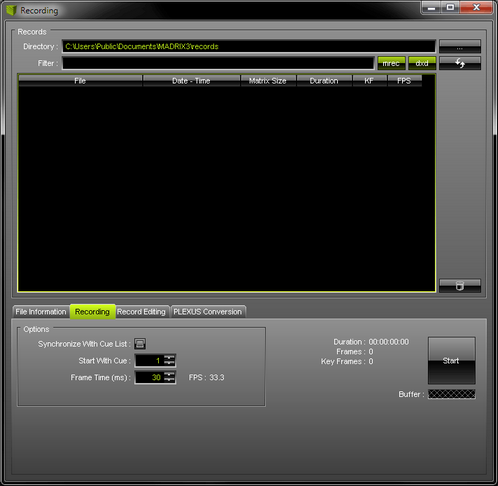
Records
Files, i.e. records, will be displayed in the large list. If you did not create any records yet, the list is empty (as shown above).
Directory
'Directory' specifies a directory on your hard disk. All record files will be saved in this folder. By default, a useful folder is already chosen for you (For example C:\Users\USERNAME\Documents\MADRIX3\records).
![]() You can change the directory. Use this button to browse for a different folder on your hard disk.
You can change the directory. Use this button to browse for a different folder on your hard disk.
Filter
Use this filter to search for specific files in the list. Simply enter a name/word and the filter will only show files that include these characters in their file name. Delete any input to show all files.
Managing Files And List Entries
![]() Shows MADRIX Record files (*.mrec) in the list that could be found in the specified directory. When activated, the button is green. Disable the option to hide all Record files.
Shows MADRIX Record files (*.mrec) in the list that could be found in the specified directory. When activated, the button is green. Disable the option to hide all Record files.
![]() Shows DMX Data files (*.dxd) in the list that could be found in the specified directory. When activated, the button is green. Disable the option to hide all DMX Data files.
Shows DMX Data files (*.dxd) in the list that could be found in the specified directory. When activated, the button is green. Disable the option to hide all DMX Data files.
![]() Use this button to refresh the list of records. Please make sure to select your preferred records directory first.
Use this button to refresh the list of records. Please make sure to select your preferred records directory first.
![]() Delete the selected file or files from your harddisk. You can also use the 'Delete' key on your keyboard.
Delete the selected file or files from your harddisk. You can also use the 'Delete' key on your keyboard.
Columns Of The List
![]()
'File' |
Shows the name of the record and its file type (*.mrec or *.dxd). Double-click on the list entry to change the name of the file. |
'Date - Time' |
Shows the time and date when the record was created. |
'Matrix Size' |
Shows the size of the virtual LED matrix (Matrix Size) used for this record in pixels x pixels x pixels. (It can be configured in the Matrix Generator or Patch Editor.) |
'Duration' |
Shows the length of the record, i.e. how long it is. The format is HH:MM:SS:FF (Hours:Minutes:Seconds:Frames). |
'KF' |
Stands for Key Frames. MADRIX will automatically optimize the file size of records if recorded frames are identical. Hence, the total number of frames can be different to the number of recorded key frames. For example, a color change (without a fade) might use only two colors. In this case, the record may have 400 frames in total, but just 2 key frames. |
'FPS' |
Stands for Frames Per Second. Shows the number of frames recorded per second of the record file. |
Window Size
In order to increase the size of the Recording dialog window, please drag the border of the window until the best size is reached. In this way you can see more files in the list.
File Information
Select the Tab 'File Information' to receive detailed information about the files you have created. Please select a file in the list first.
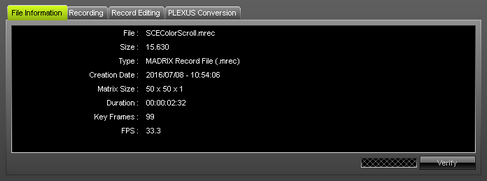
Recording
Select the Tab 'Recording' to create a new record.
Preparation
Please make sure to do Step 1), 2), and 3) before recording.
Important Note
Please note: Only the Main Output will be recorded. Make sure that your content is displayed on Preview Window Output before you record.
Options
Please configure the following options before recording.
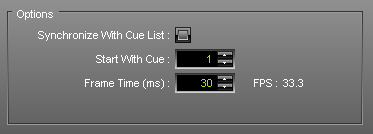
'Synchronize With Cue List' will create a record according to your preprogrammed Cue List. If this option is activated, the Cue List will automatically start to play when the Recording is started (by clicking on the button 'Start').
'Start With Cue' allows you to specify which Cue List entry should be used first, when you wish to use the function 'Synchronize With Cue List'.
'Frame Time (ms)' defines the frame rate of the record.
Please adjust the frame time to the requirements of your LED fixtures and devices!
Please note: A frame rate (FPS) that is too high might cause problems. Those can be visual problems on your LEDs, for example. For the MADRIX PLEXUS a maximum frame rate of 40 FPS is recommended. Otherwise, PLEXUS devices may drop single frames to maintain the timing. PLEXUS devices are likely to drop frames in order to maintain the timing, when all 512 DMX channels of a DMX universe are used. If your DMX universes contain less than 512 channels (324 DMX channels, for example) this behavior is less likely. |
Creating A Record File
Please make sure to configure all available options before recording (see above).
Step 1)
 Begin recording by clicking on 'Start'. MADRIX will start to record the Main Output. Please note: When recording without a Cue List, you can change Storage Places, use the crossfader, use the Master, etc. in order to customize your record.
Begin recording by clicking on 'Start'. MADRIX will start to record the Main Output. Please note: When recording without a Cue List, you can change Storage Places, use the crossfader, use the Master, etc. in order to customize your record.
Step 2)
 Various information will be displayed.
Various information will be displayed.
The Duration is displayed in HH:MM:SS:FF (Hours:Minutes:Seconds:Frames).
Step 3)
 Simply click 'Stop' to end the process. Please wait a few seconds to let MADRIX process the data. Afterwards you will need to enter a name for the new record.
Simply click 'Stop' to end the process. Please wait a few seconds to let MADRIX process the data. Afterwards you will need to enter a name for the new record.
Step 4)
Afterwards, you will see your record in the list.
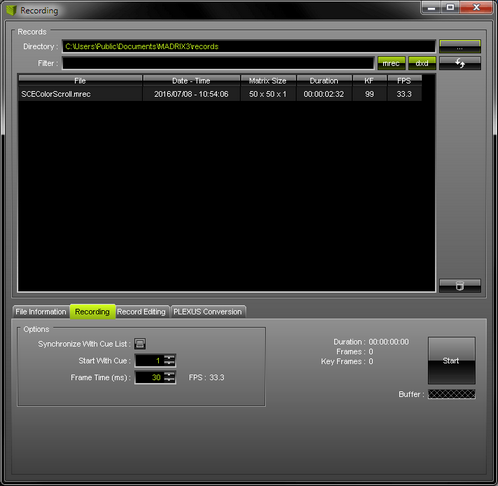
Record Editing
After creating your record, you can edit your record.
First, please select your Record File in the list. Second, change to the tab 'Record Editing' in the 'Recording' window.
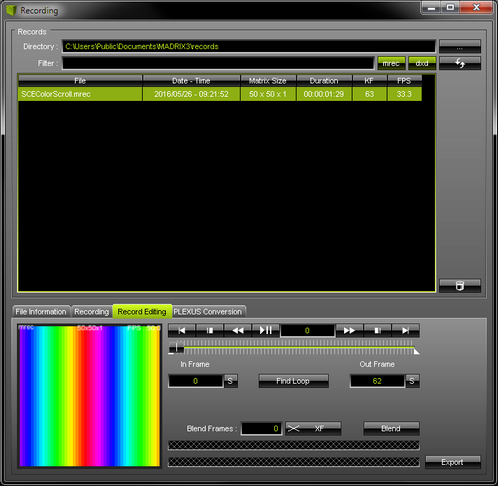
A small preview window is provided in the lower left to inspect the record.
Please note: If you see the message !NO MADRIX KEY!, that means that you are using MADRIX in demo mode. However, this is no problem. Your record will NOT include this text!
Use the provided controls to edit your record. That means you can preview, trim, and loop your record. First, select a list entry. Trim the record by setting up a new In Frame and a new Out Frame.
|
Use the slider to select a specific frame. |
|
This field displays the current frame that is also shown in the small preview window. Enter a number to jump directly to this frame. |
|
Starts or stops the preview playback. |
|
Rewinds or forwards one frame per click. |
|
Skips directly to the In Frame or the Out Frame. |
|
Skips to the beginning or the end of the record. |
|
Enter a number or use the slider to select a specific frame. Then, use the 'S' button to set the In Frame (start frame). |
|
Enter a number or use the slider to select a specific frame. Then, use the 'S' button to set the Out Frame (end frame). |
|
MADRIX will search the Record file in order to find a segment that is loopable. It will automatically set the In Frame and Out Frame afterwards. Use the button 'Export' to export your loop. Before that, you can also insert 'Blend Frames'. |
|
Insert 'Blend Frames' into your record. First, enter the number of frames you wish to use. This defines the length. Second, choose the fade mode (XF: Cross-Fade, WF: White-Fade, BF: Black-Fade). Third, click 'Blend'. Fourth, use PlayPause to preview the edited record. Fifth, use the button 'Export' to export your loop. |
|
Exports the edited record. Choose a name in the second step. |
